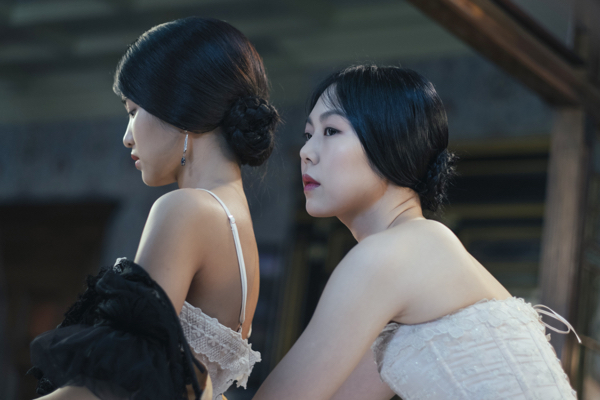Movie review by Greg Carlson
Master director Chan-wook Park’s diabolically pleasurable “The Handmaiden” delights the eye with its sumptuous costumes, production design, and photography, and also tickles the imagination with its structural gamesmanship. While it seems that the majority of films tagged “erotic psychological thrillers” fail to satisfy even one of that trio of descriptors, Park – at the top of his strong game – delivers the goods and then some. Inspired by Sarah Waters’ novel “Fingersmith,” Park’s movie, through its careful application of con artistry and class consciousness, also recalls aspects of “Dangerous Liaisons” and brings a hint of “Raise the Red Lantern” into play as well.
Presented in three parts, “The Handmaiden” follows undercover hustler Sookee (Tae-ri Kim) as she infiltrates the bedroom of Lady Hideko (Min-hee Kim), the wealthy niece of a powerful master and collector of shunga and other rare pornographic scrolls, tomes, and folios. In league with fellow grifter “Count” Fujiwara (Jung-woo Ha), with whom she intends to split Hideko’s sizable inheritance, Sookee’s job is to convince her mistress to elope with Fujiwara. The intriguing roundelay, party to several twists and turns revealed in flashback, provides Park with a sensuous stage on which he can explore sex as power, sex as weapon, and sex as release.
The potential pitfalls and snares are many, but Park somehow manages to thread the needle between the kind of softcore, tongue-in-cheek jape that treats onscreen lovemaking as a kind of elaborately choreographed pas de deux and an earnest examination of unclothed connection. Most popular cinematic depictions of anything even close to BDSM struggle to resist simplifying kink and pathologizing attendant behavior as unhealthy, abnormal, or wrong. Uncle Kouzuki (Jin-woong Cho) appears to fit that bill, commanding Hideko to theatrically narrate explicit literature for an audience of guests who come to luxuriate as well as buy, sell, and trade books and artwork.
Set in Korea during the Japanese occupation and featuring helpful color-coded subtitles that distinguish between the two principal spoken languages, “The Handmaiden” keeps a close eye on the dangers of being a woman under the control of an entitled male authority figure. As Manohla Dargis points out, Hideko is both puppet and bird in a gilded cage: she lives with the constant threat of violence, which Park partially imagines through the metaphor of Kouzuki’s dreaded basement. Park will indeed invite the viewer to visit that mysterious underfloor vault in a manner befitting the director’s penchant for stark, grim comeuppance.
While the plotting of the narrative depends on the quartet made up of two men and two women, Park confidently shifts among the permutations. A serpentine Sookee/Hideko/Fujiwara triangle coexists with a perilous relationship between the lady of the house and her handmaiden. In one scene, Sookee files the sharp edge of Hideko’s tooth during a bath, gently probing mouth with finger. The slippery, humid sequence is as pulse-quickening as a number of Park’s other period tableaux, many of which reach for the unknown pleasures, confounding ecstasies, and possibility of force displayed in Hokusai’s “The Dream of the Fisherman’s Wife” – a famous image included by Park in “The Handmaiden.”
